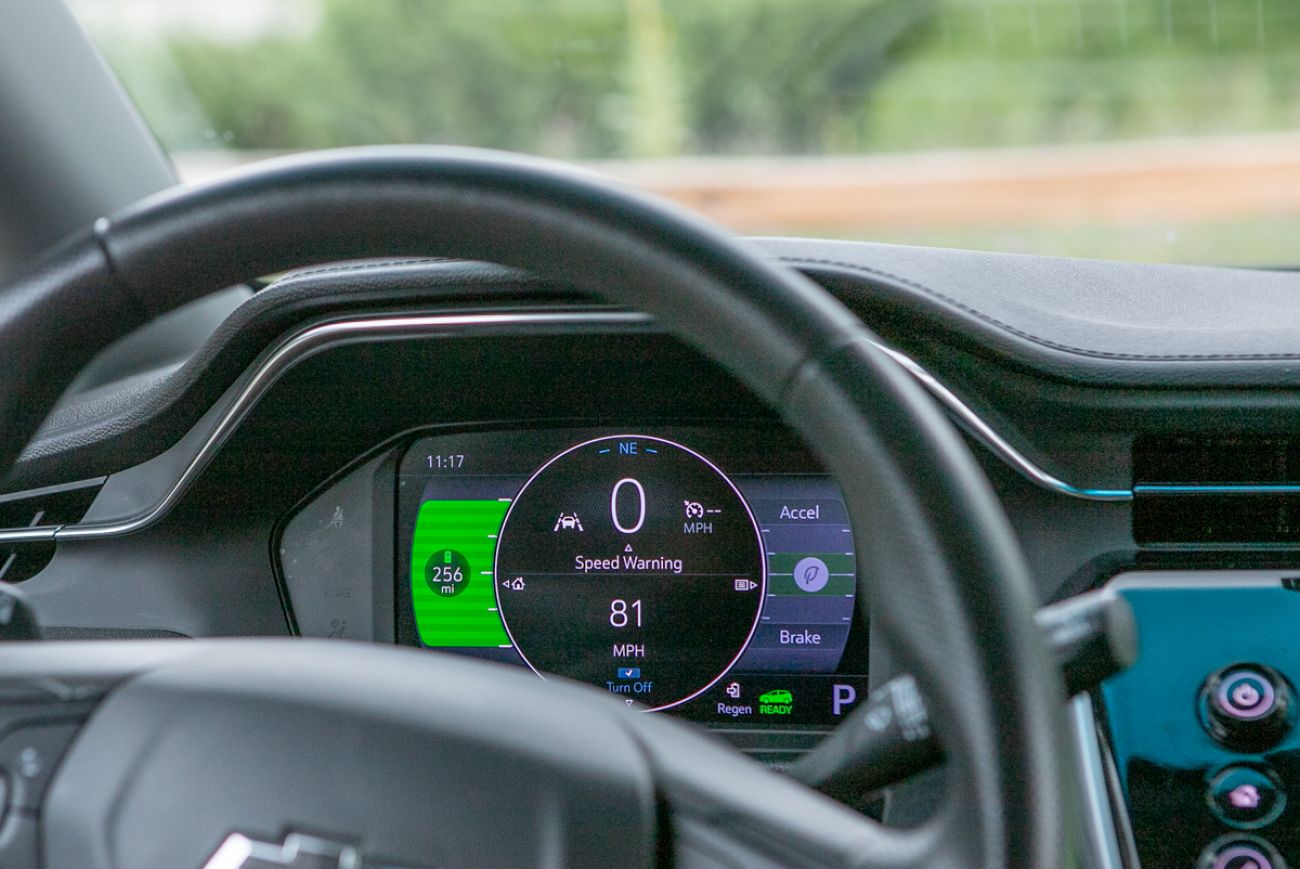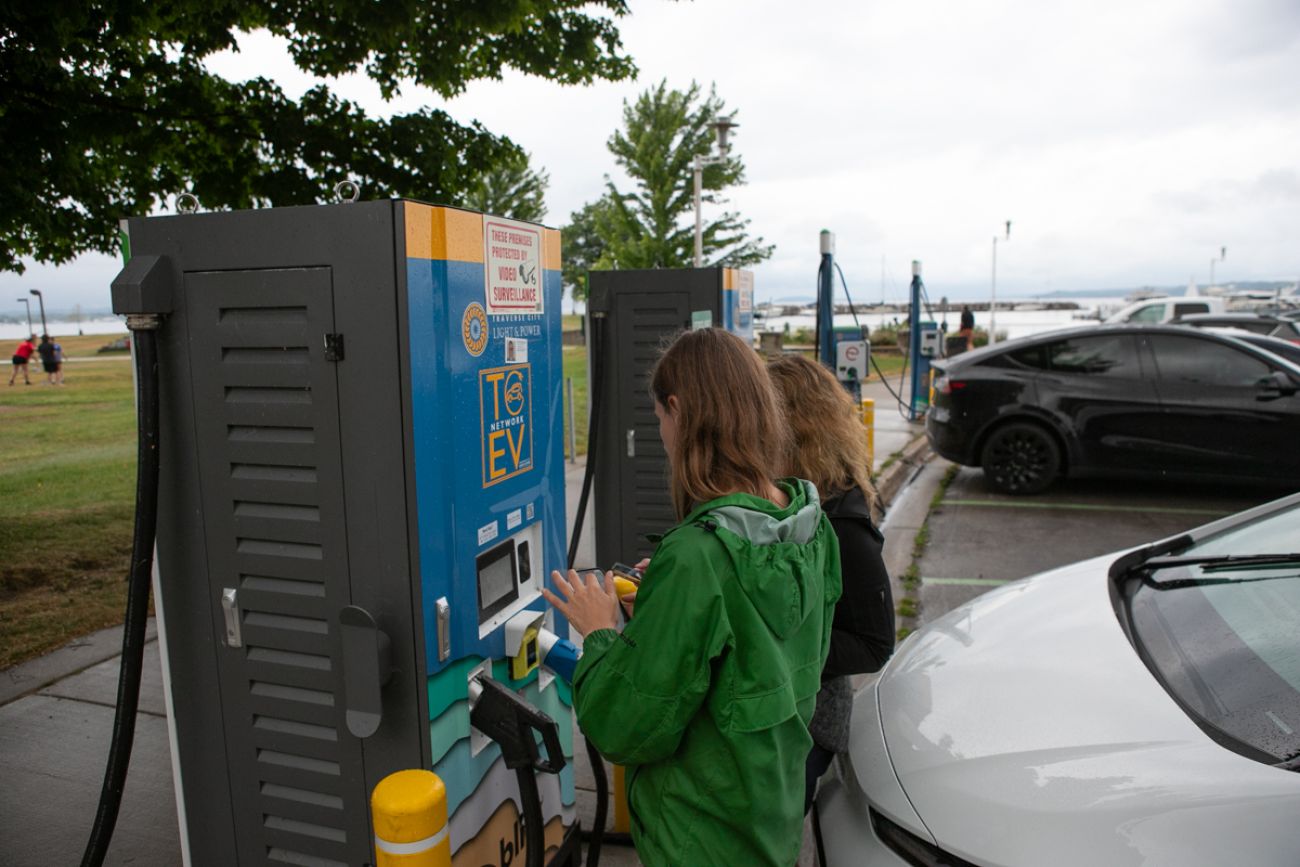Always have a backup plan & other lessons from Bridge Michigan’s EV road trip

- Bridge’s EV road trip showed real-world experiences of three reporters taking a trip around Lake Michigan
- Charging presented the steepest learning curve, and the area that most needs system-wide improvements
- Each reporter could see herself eventually buying an EV, even as many questions remain about when they’ll be easier to take on road trips
Driving around Lake Michigan from Holland to Menominee in the Upper Peninsula offers an amazing roadside glimpse of the state.
Put three Bridge Michigan journalists into a rented Chevy Bolt electric vehicle for a five-day excursion on that same route, and the trip shows the state has a long way to go to support a shift to EVs.
The trip allowed us to experience firsthand both the positives and negatives of EVs, especially when it comes to frustrations over a lack of public chargers in Michigan’s tourist areas.
It’s a big issue: Consumer perception has an outsized impact on automaker and policymaker decisions that have even bigger implications for the environment and economy.
This year, for example, a recent Gallup survey showed that 48% of Americans would consider an EV purchase, up from 41% a year earlier. Range and charging anxiety follow price among Americans’ concerns.
This is what business reporter Paula Gardner, environment reporter Kelly House and digital marketing specialist Asha Lewis learned about EVs and their reliability on a road trip around Michigan:
Our 2 cents
The experience left each of us open-minded about choosing an EV for personal use.
We based that on our experience with the car, since it accommodated all of our necessities, including camping equipment like three sleeping bags and three tents.
It also handled well, with a peppy acceleration. And all of the other aspects — like the air conditioner — kept us comfortable.
Related:
- 2024 Michigan EV road trip
- Five days, 1,180 miles, lots of headaches and fun: Driving Michigan in an EV
- EV road trip update: We’re home after more than 1,000 miles
- Road trips are key to making EVs work in Michigan. They’re doable now. Barely
- Up North businesses help fill Michigan’s EV charging station gap
- EV transition a slow go in Michigan. It needs 100,000 chargers, has 3,300
But the big deal was the charging and whether we felt like we could manage it on that trip — and, if we choose to buy an EV, beyond.
In the end, we spent about 27 hours charging (including overnight at our lodging), adding 1,164 miles onto our battery, at a total cost of $108.
The same trip in a conventional car that gets 25 mpg would cost about $175, with gas at about $3.75 a gallon.
So, the EV was significantly less expensive, but a far greater time investment and occasional source of stress when it came to fueling.
Admittedly, Chevy Bolts recharge far slower than the average EV. So we were starting from a disadvantage. (Editor’s note: We rented from Hertz and did not have a say in the car we received.)
Michigan needs more chargers
We chose our route because it follows a popular tourism circuit that state officials are prioritizing for charger deployment.
Gov. Gretchen Whitmer vowed in 2021 to make the Lake Michigan Circuit “the best new road trip for electric vehicle owners in America.”
But it took us less than a day to run into problems caused by a mismatch between charger supply and demand at popular destinations, where EV owners looking to refuel often outnumber available chargers.
We were only able to snag one of the two chargers at Muskegon’s Pere Marquette Park because our interview subject got there early and saved us a spot.
As our trip continued, we encountered broken chargers at key moments, wide gaps in the charging network that caused us to nearly run out of battery power near Sleeping Bear Dunes, and a paucity of fast chargers that set us behind schedule as we were forced to refuel at slower Level 2 stations.

These challenges didn’t come as a surprise: We knew going in that Michigan has fewer chargers than it needs to support the EV transition.
State officials estimate Michigan needs 100,000 public chargers to put 2 million EVs on the road by 2030. It will need even more for a full EV transition. Yet today, there are only about 3,400.
On the Lake Michigan Circuit specifically, Michigan State University researchers found a need for 763 more chargers within 10 miles of the shoreline. So far, the state has enough money to build about 115.
In the end, we found there were enough chargers to get us from Ann Arbor to Menominee and back. But barely.
Industry needs to streamline charging
Beyond just having enough chargers, experts say those chargers need to be easy to use.
On our trip, we learned there’s work to do there, too.
Fueling up an EV is far more complicated than stopping for gas, thanks to a frustrating lack of industry standards around payment systems and plug points.
Many charging stations don’t have credit card readers. Instead, users must download proprietary apps to initiate and pay for a charge. In rural areas with spotty cell phone reception, that can be an impossible task.
We got lucky: Experienced readers had advised us to download apps for the most common charging companies before starting our trip. We did, but we still had to download two more on the road, prolonging the already time-consuming charging process.
Our trip also underscored the need for plug standardization. Few things are more frustrating than driving past unoccupied chargers when your battery is nearly dead.
But that’s exactly what we were forced to do on Tuesday, because our Bolt’s CCS 1 plug was not compatible with the SAE J3400 outlet (also known as a Tesla outlet) as the only charger within a 30-minute drive of Sleeping Bear Dunes.
Other times, we waited in line to use a compatible charger while multiple adjacent Tesla stations sat empty.
The industry is moving toward plug standardization, and several automakers have begun offering adapters to make their vehicles compatible with the large network of Tesla chargers, which make up nearly 60% of U.S. public chargers.
By 2025, most automakers plan to sell vehicles equipped with the Tesla-developed outlet. That’s sure to bring relief to frustrated drivers.
So-so customer experiences
Filling a vehicle with gasoline is very predictable, and there are many parallels to EV charging.
You pull up to a tall, narrow device, and attach a plug to your vehicle. Fuel is dispensed. A screen keeps track. And you’ll most likely refuel amid a bank of power sources, whether designed for so-called ICE (internal combustion engine) vehicles or EV.
But the familiarities end there. Consider our experiences:
- When a bank of chargers was full, we saw no indicators of when a plug may be available. If a driver was already charging, the time spent waiting was open-ended, unless we asked.
- In no case did we find a canopy over the chargers to protect a driver from rain, snow or — notably in July — direct sun on 90-degree days.
- How much is the charge? That was largely unclear. While easy to tell what you pay per gallon of gas, the charging rate can be a mystery as you drive by a charger, pull in and even after you complete your charge. In one case, about 30 minutes with a fast charger resulted in a $40 credit card hold that lasted for two days until we learned we’d paid $18.50.
- What’s nearby? Probably nothing. Even in busy grocery store parking lots, the EV chargers are tucked into a far corner.
- EV charging requires some strength. The plugs are heavier than gas hoses and sometimes require some twisting and turning.
Individually, these are all small things. Collectively, however, these are the refueling experiences that made Bridge reporters pause and think: Why is the charging experience so lacking, this far into the EV shift?
Does buying an EV make sense?
Many readers contacted us for more information, indicating that they were considering an EV lease or purchase.
Our conclusion: Determining whether an EV fits an individual’s budget means looking far deeper into the vehicle, beyond sticker price to overall cost of ownership.
On the surface, EVs are more expensive. The average EV price in June was $56,371, compared to $47,433 for a light vehicle with an internal combustion engine.
Tax credits can cut the sticker price. However, the list of vehicles eligible for the full $7,500 credit is relatively small this year, according to a report in Car and Driver, due to stringent rules about battery content. (Some plug-in hybrids are eligible for a $3,500 tax credit, according to the IRS.) The IRS also sets income limits for the tax credit.
Home chargers could cost up to $3,000, according to many reports, but rebates also are available.
Some calculations show it’s less expensive on an annual basis to fuel an EV than a gas-powered car, by about $700 per year. However, that comes with many variables, including what you pay for electricity at home and how often you’re paying to use a public charger.
Anderson Economic Group of East Lansing compiled reports on the real-world costs of fueling EVs and how they compare to gas vehicles. The most recent data is from 2022 but it shows the many considerations, including taxes paid and “lost” time spent fueling up. (At the time, EVs only only showed an advantage among luxury vehicles, but since then smaller EVs and trucks were added to the market).
Maintenance costs also pose questions. EVs have fewer parts, but some are more costly to replace. A new EV battery may cost $20,000 compared to a $10,000 ICE engine; yet an EV may last longer, with some suggesting the lifespan is up to 20 years, compared to 12.5 years for the average gas vehicle on the road.
Someone cost-conscious who is considering an EV may want to weigh their driving styles and needs with all of the above, then also factor in insurance costs. At times, insurance has been up to 20% more expensive, but reports indicate the gap may be closing.
We need more semi-private chargers
While planning this trip, we took care to search for lodging where we could charge overnight. But it wasn’t always available.
Charging overnight is the most convenient charging option to a traveler. While Airbnb and other lodging operators say queries about EV charging availability are increasing, chargers still are not widely available in all areas.
In our case, we were cheerfully told one night that we could plug into any exterior outlet, which gained us about 6 miles per hour spent charging, or about 48 miles.
In another case, we parked the car at the center of a resort and walked back to our rented condo — in the rain — for a welcomed Level 2 overnight charge.
Both evenings, we were grateful that the charge was possible and that we did not have to compete with other drivers.
But the situation we encountered underscored what some businesses in northern Michigan recognize: Adding chargers benefits drivers and their businesses.
Bottom line
This trip was not as bad as we feared, not nearly as good as we'd hoped. (Though we are proud to have survived one night of camping midway through).
While Michigan has made good strides toward making road trips possible in an EV, it has a long way to go before they become carefree enough for most casual drivers.
Michigan Environment Watch
Michigan Environment Watch examines how public policy, industry, and other factors interact with the state’s trove of natural resources.
- See full coverage
- Subscribe
- Share tips and questions with Bridge environment reporter Kelly House
Michigan Environment Watch is made possible by generous financial support from:
Our generous Environment Watch underwriters encourage Bridge Michigan readers to also support civic journalism by becoming Bridge members. Please consider joining today.
See what new members are saying about why they donated to Bridge Michigan:
- “In order for this information to be accurate and unbiased it must be underwritten by its readers, not by special interests.” - Larry S.
- “Not many other media sources report on the topics Bridge does.” - Susan B.
- “Your journalism is outstanding and rare these days.” - Mark S.
If you want to ensure the future of nonpartisan, nonprofit Michigan journalism, please become a member today. You, too, will be asked why you donated and maybe we'll feature your quote next time!






